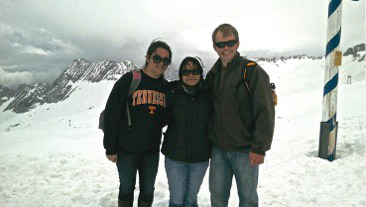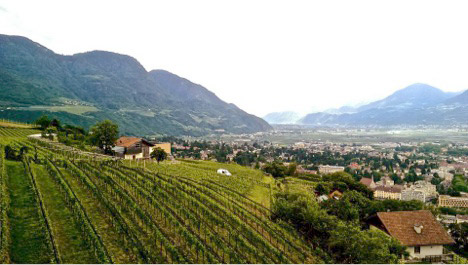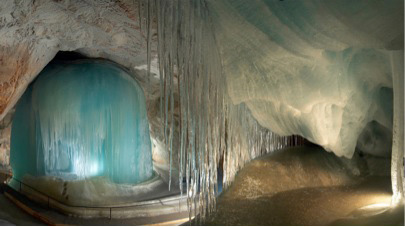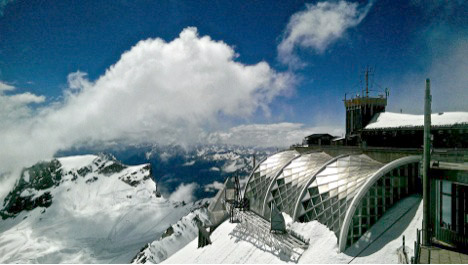Student Reports: Engineering in Austria, 2014
Kelly Nicholas, Thuy Trieu, and Will Hoskins, 2014

Our study abroad experience took place in the city of Innsbruck, Austria, which is nestled in a valley in the Austrian Alps. Immediately after arriving, we realized we were entering a completely different environment. While we may have been uncomfortable at the beginning of the course since we were in a foreign country with a culture that was dramatically different than that of America, we became aware that the challenge that was presented before us was one that would help shape our personalities and redefine the way we viewed the world.
Our study abroad program was through the engineering department at the University of Alabama. A professor from the University of Alabama accompanied us on our trip. Students had two courses available to them. All students who came on the trip took the Water Resources Course (CE 470) and had the option of staying longer and taking a Glaciology Course (CE) as well. Both courses either counted for an engineering technical elective credit or as major credit (for civil engineers). The students who only took the Water Resources course were abroad for three weeks, while those who took both courses were abroad for five weeks.

The Water Resources course focused on water management from an engineering perspective. We primarily studied two main topics. The first half of the course focused on the relationship between climate change and glacier volume loss, along with assessing the repercussions associated with the loss of glaciers on a water system.
Much of the course work for the first half of the class focused on the calculation of glacier volume loss from actual data used in research and assessing the annual percentage of stream flow from a given watershed that was attributed to glacier volume loss. The second phase of the water resources course dealt primarily in dendrochronology, which is the study of tree ring analysis. We found that tree rings can be very useful for both cross dating to determine the age of older trees.
The fact that we learned about cross dating trees was initially very surprising, but, interestingly, stringing together a long history of tree ring data from a given location can be very useful as an engineer because the width of tree rings indicate how good the conditions for tree growth was during that particular year; when water is the limiting factor in tree growth, a reconstruction of the amount of water received that year can be recreated. Using tree core data, stream flow reconstructions can be added to the very limited stream flow database. Using stream flow reconstructions, we find that the past century has been a very wet one compared to centuries before that. This information must be taken into account by civil engineers who focus in water management, as they must be prepared for the lack of moisture caused by natural variation in climate.
During the water resources course, we had a total of seven field trips, in which three of the seven trip applied to the course material. The first field trip was to the Stubaier Glaciers on May 8. That morning after breakfast, all of the students piled into taxis of different sizes and was driven to the glacier site. The ride to Stubaier was about forty-five minutes along a scenic route with many little cottages surrounded by fields of green and the occasional farm animals (horses, sheep, goats, or cows), pine tree forests, the side of a mountain, and a crystal clear river (with occasional mini waterfalls) from the melted glacier. Once we arrived at the drop of site for ground transportation, we took a cable car up the side of the mountain to the glacier site.
After twelve minutes of being engrossed in beautiful mountain scenes, we arrived at the Stubaier glacier site. The site mainly consisted of snow and lots of skiers and we couldn’t really see the glacier because it was hidden. We walked around and took a few pictures of the view of the snow and mountains. Afterwards, a few of us went to eat and a few went to ski. After a few hours, the students who didn’t want to ski went back to the hotel and the students who were skiing stayed for a few more hours.

The second trip we had was to the ice caves in Werfen, Austria. The bus ride to Werfen was about two hours; thirty minutes of that ride consist of the bus driver carefully maneuvering up a paced, winding, mountainous road. Once the bus driver got to the bus parking area, we got off and hiked twenty minutes to the cable car that took up to close to the ice caves. During this twenty-minute hike, we encountered many breathtaking scenes; we took many photos but none were able to capture the amazing feeling of standing 1,000 meters above sea level and looking down to see the green pastures and red-roof buildings, looking across to see the miles and miles of green pine forest, and looking up to see the beautiful blue skies that seems endless. After we ride the cable car to get further up the steep mountain (1,500m), we hiked twenty to thirty minutes through the cloud-covered, rocky, steep, fenced path. During our hike, it started to mist but it wasn’t extremely cold.
Once we arrived at the ice caves, we took more pictures of the entrance and waited fifteen minutes for the next English tour. The ice cave tour was approximately forty-five minutes long with a hike up 700 steep steps along one kilometer of the forty-two kilometer cave (only one kilometer is covered in ice because of the temperature of the cave is able to stay below freezing with the cave insulation and the elevation). During the hike, the tour guide pointed out famous ice formations and explained to us the importance of the formations. Formations that we saw during the tour include: the elephant, the piano chord, Yetti palace, ice palace, and a wall of ice. After the ice tour was over, we hiked down 700 steps to go back to the cave entrance. Once we stepped out, it was snowing outside! We took more picture of the beautiful snow. We then hiked down the steep mountain and stopped at a restaurant next to the cable car to warm up and get some lunch. Afterwards, we rode the cable car down to the bus and drove to Salzburg to spend the night.

The last trip that we took was to Zugspitze, a glacier and the highest point in Germany. We took a one and a half hour bus ride to the base of the mountain and then took a forty-five minute train up the side and through the mountain. Once we arrived at Zugspitze, we walked around the snow, took pictures, and had a snowball fight. Afterwards, we went into the café and ate. Afterwards, we took a large cable car up to close to the highest point and saw a beautiful view of the Wetterstein Mountains. The highest point was called The Summit, which is represented with a golden summit. We spent about an hour up there taking pictures and hanging out with the students. Afterwards, we took a big cable car down the side of the mountain and then headed back to Innsbruck.
First and foremost, this experience instilled in all of us a love and aptitude for international travel and culture. The second we stepped foot out of the United States, we had to forget everything we know and function gracefully in countries with incredibly varying customs. From trying to figure out how to order a simple glass of water at a restaurant to attempting to navigate the winding alleys of Rome, everything we did abroad was exciting, perspective broadening, and personally challenging. We all gained tact, confidence, and the ability to graciously stick our feet in our mouths. It is great to be taken out of your comfort zone and see the way people and practices differ across the world- not only culturally, but also in engineering.
European approaches to transportation, environmental issues, and resource management are all vastly different than those of the United States. Being able to see and experience these differences in person really opened our eyes to better solutions and practices that could be incorporated at home in the US. We all have grown so much and are greatly changed as students, future engineers, and citizens of planet Earth.
